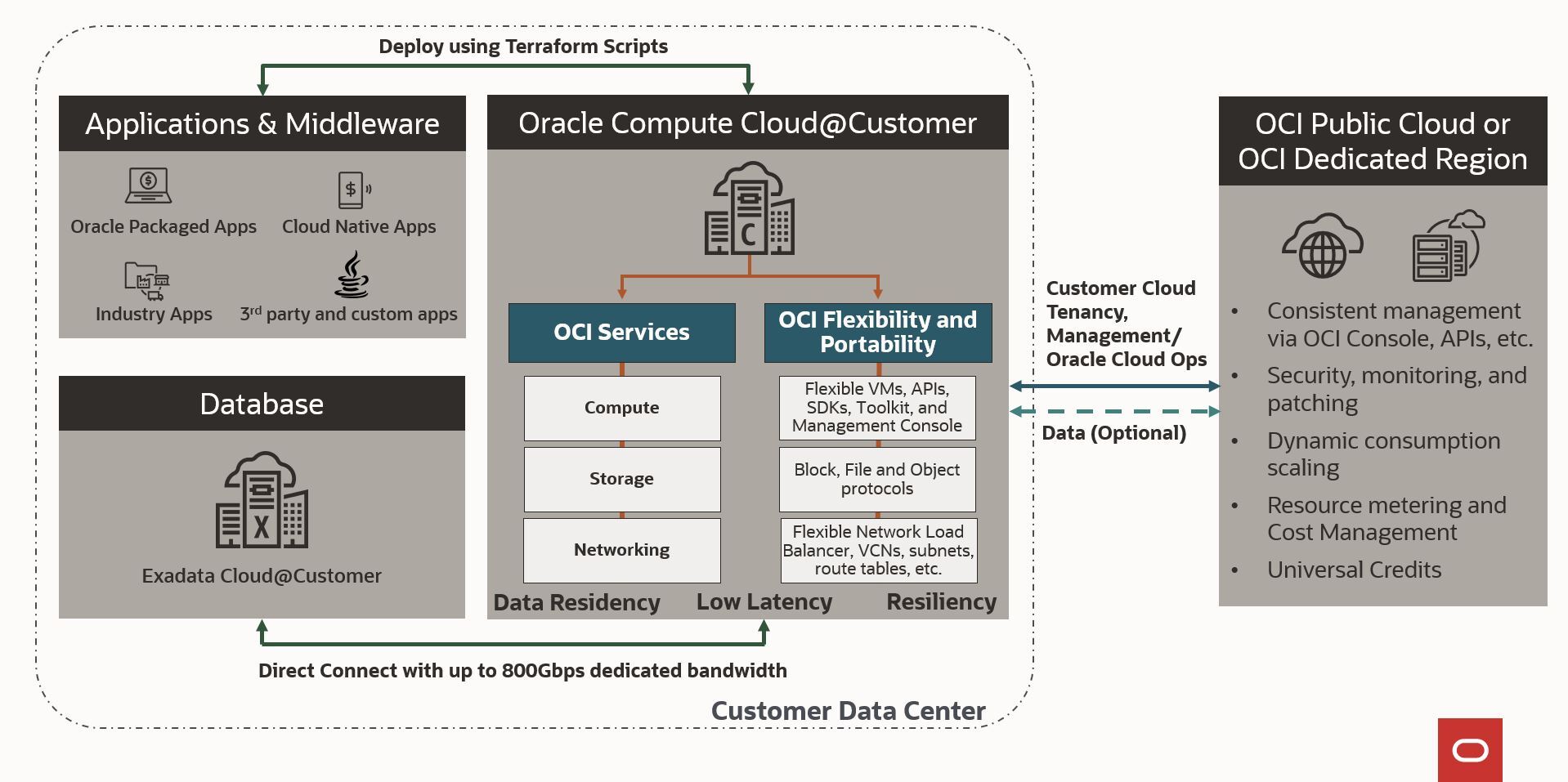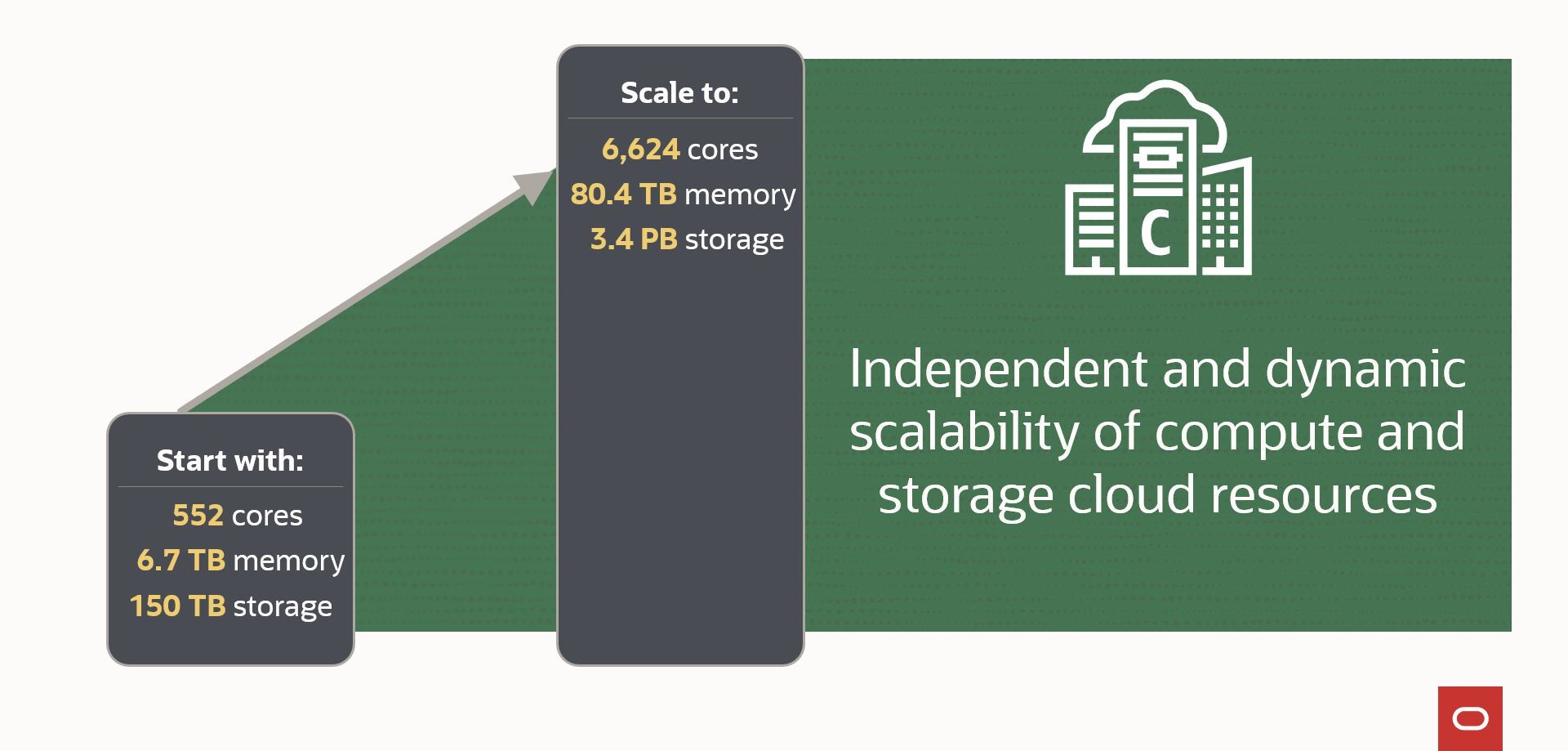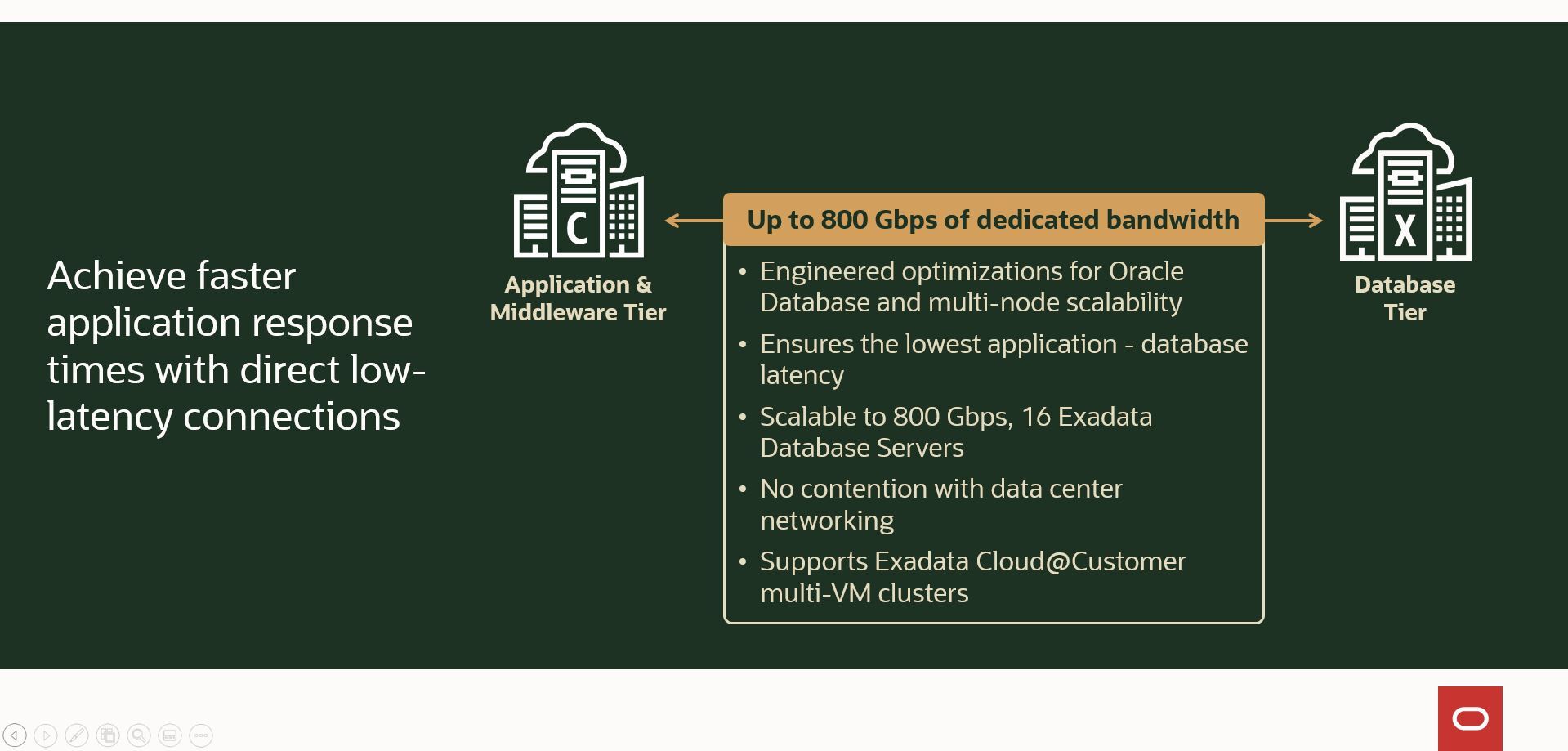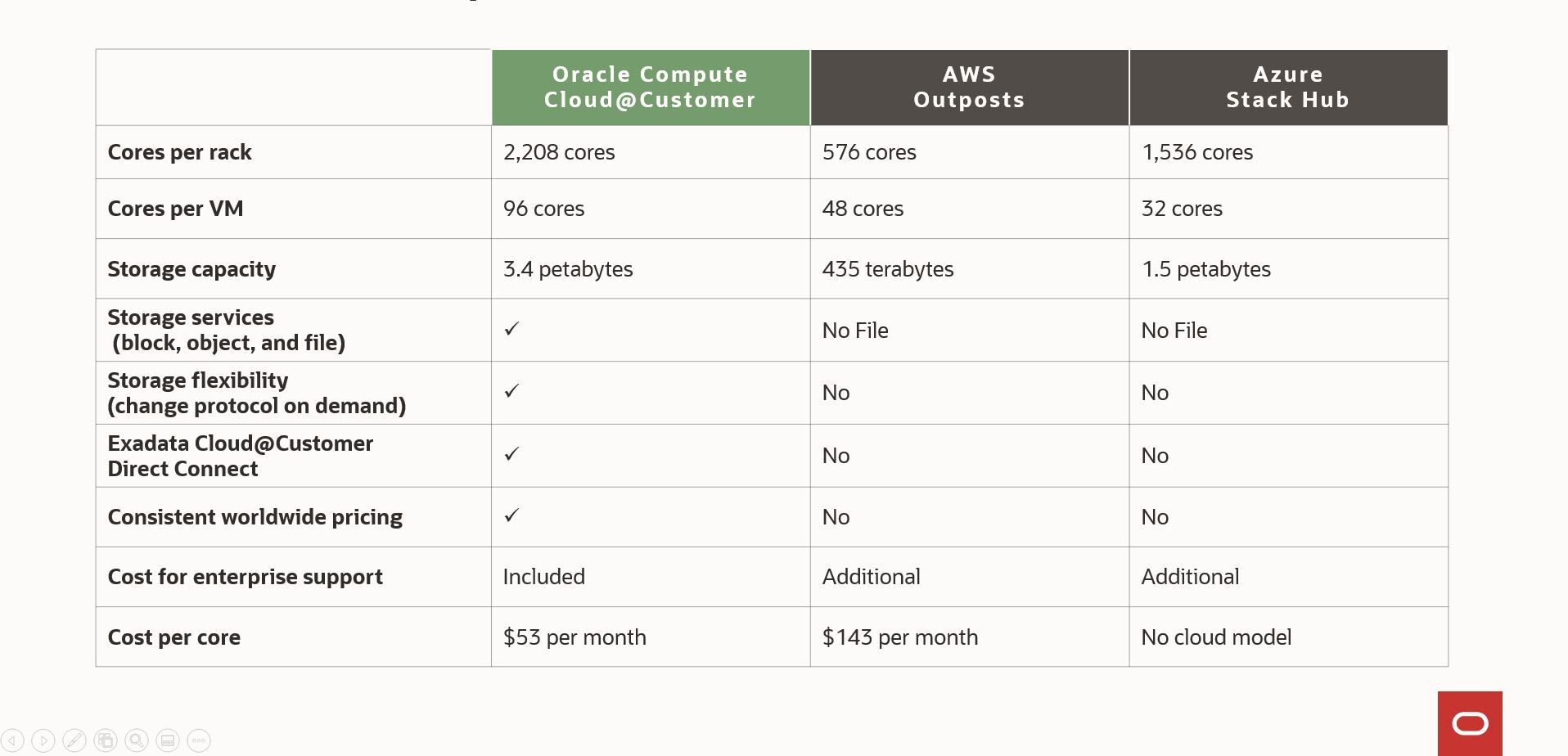We’re excited to announce the latest addition to the Oracle Distributed Cloud portfolio: Oracle Compute Cloud@Customer, a fully managed, rack-scale infrastructure platform that lets organizations run enterprise and cloud native workloads on Oracle Cloud Infrastructure (OCI) Compute. Compute Cloud@Customer is built, installed, owned, and remotely managed by Oracle, so you can focus scarce IT resources on growing your business and improving operating efficiency.
With Compute Cloud@Customer, you can cost-effectively run middleware and applications with high performance, availability, and cloud economics. By locating it in your data center or distributed data centers, it helps you meet data residency requirements and the need to distribute cloud resources close to end-users. For Oracle Database-intensive workloads, such as Oracle packaged applications like PeopleSoft or E-Business Suite, you get an optimized full-stack distributed cloud environment by directly connecting Compute Cloud@Customer to Oracle Exadata Cloud@Customer by the lowest latency connection to the fastest and most versatile cloud database platform available.
What is Compute Cloud@Customer?
Compute Cloud@Customer is built using 4th Generation AMD EPYC processors with 96 cores per processor and DDR5 memory. You can subscribe to increments of 552 available processor cores with 6.7 TB of available memory. You can increase the size of your initial subscription or dynamically scale your Compute Cloud@Customer platform later by adding similar sized increments, with up to 2,208 cores available in a single rack and 6,624 cores overall. This configuration provides you with 3.8 times the number of cores per rack as an Amazon Web Services (AWS) Outpost system and 1.4 times the number available with the densest Microsoft Azure Stack Hub system that we’ve been able to find. No matter what size of Compute Cloud@Customer infrastructure you deploy, you only pay consumption on the amount you use.

Figure 1: Compute Cloud@Customer capabilities
Compute Cloud@Customer takes a similar approach to storage, but with an extra twist. The smallest configuration comes with 150 TB of usable storage capacity, which you can expand to 3.4 PB. The twist is that Compute Cloud@Customer lets you use storage in any way you want: 100% object storage, 80% object and 20% block, 40% object, 30% block, and 30% file—all no problem. If you’re only using 50 TB of capacity, you only pay consumption on that 50 TB, substantially reducing your costs.
Compared to AWS Outposts and Azure Stack Hub, Compute Cloud@Customer’s flexible storage capabilities provide you with more value since these other platforms support much less storage capacity, provide much less flexibility, and charge you for storage consumption. For example, neither AWS Outposts nor Azure Stack Hub support file storage protocols, forcing you to use different storage systems for those workloads. Furthermore, AWS Outposts have limited storage capacity with up to 380 TB of object storage and 55 TB of block storage that can’t be redeployed for other uses. Compute Cloud@Customer has up to 7.8 times the total amount of storage and lets you use it any way you choose.
Azure Stack Hub does support up to 1.5 PB of storage, but that’s still less than half of the capacity of Compute Cloud@Customer. Finally, with AWS Outposts, you pay full price for your storage capacity whether you use it or not, which makes it much more expensive than Compute Cloud@Customer. With Azure Stack Hub you must buy or lease your entire hardware stack from someone like HPE or Dell, which breaks the entire cloud model and eliminates the benefits of single-vendor support.

Figure 2: Compute Cloud@Customer scalability
If you need high performance for your workloads or run traditional packaged applications, virtual machine (VM) scalability might be as important as overall scale. Here, Compute Cloud@Customer also provides you with unique capabilities. Oracle has brought flexible VMs from OCI to Compute Cloud@Customer, enabling you to run VMs with 1 to 64 GB of memory per core and scale a single, large VM with as many as 96 processing cores and 960 GB of memory for compute- and memory-intensive applications.
This offering is two to three times the maximum VM size you get with AWS Outpost and Azure Stack Hub, a big deal for some applications. You can more easily move existing compute and memory hungry applications to Cloud@Customer than if you were using one of these other systems. If your application needs 4 cores and 256 GB of memory, you don’t need to provision 16 cores to get the amount of memory you need with fixed memory shape available on other platforms. With Compute Cloud@Customer’s flexible VM shapes, you operate more efficiently and only pay for the resources you use.
These core capabilities let Compute Cloud@Customer deliver high performance and scalability for OCI Compute and the storage and networking capabilities you need to run middleware and application workloads in an efficient and cost-effective manner. APIs, CLI, software developer kits (SDKs), Toolkit, and Management Console in Compute Cloud@Customer are the same as those in OCI, enabling you to develop applications once and deploy them anywhere in the Oracle Distributed Cloud, from OCI data centers to your data center and locations close to your customers. Compute Cloud@Customer also enables you to fully control where your data resides throughout its lifetime to meet stringent data residency requirements or replicate it to another Compute Cloud@Customer or OCI Region for disaster recovery purposes.
Compute Cloud@Customer and Oracle Exadata
Compute Cloud@Customer offers the unique ability to directly connect to Exadata Cloud@Customer and Oracle Exadata Database Machine. With up to 50 Gbps bandwith per database server and up to 800 Gbps overall, you have a secure, low latency, private connection between the application and middleware tier of your stack and the database tier. You get the lowest possible latency for both accessing the database and within the database itself, improving application-level performance and scalability. You also get a single-vendor environment for distributed cloud resources in your data center that’s all managed from the same console and maintained by one, proven provider, Oracle.

Figure 3: Compute Cloud@Customer to Exadata Cloud@Customer direct connection
Compute Cloud@Customer economics
Compute Cloud@Customer uses subscription plus consumption pricing that delivers cloud economics in your data center. You pay an affordable monthly subscription to have Compute Cloud@Customer installed in your data center and then only pay for the resources you consume. Even if you use all your capacity, Compute Cloud@Customer costs substantially less than most other cloud provider data center offerings. If you consume less than 100 percent—I don’t know any customers that fully utilize their platforms—you pay a lot less than you would with other systems that have fixed prices no matter how much of their resources you consume.
As a result, you get a superior cloud economics model with Compute Cloud@Customer compared to other cloud providers’ offerings. You can also use OCI Metering and Cost Management to track usage and consumption of Universal Credits on Compute Cloud@Customer, Exadata Cloud@Customer, and in OCI. Using the same credits to pay for consumption across all environments means that if you move a workload from one to another, you’re not stuck paying for unused consumption on the original platform.
Compute Cloud@Customer comparative benefits
We’ve covered a lot of ground in this blog, both from the perspective of Compute Cloud@Customer and how it can benefit you more than alternative offerings. The following table brings these points into greater focus.

Figure 4: Compute Cloud@Customer competitive differentiation
Conclusion
If you have middleware and application workloads that could use a performance boost and need to meet data residency and security requirements with a simple, cost-effective cloud consumption model, then Oracle Compute Cloud@Customer is right for you. It’s a fully managed infrastructure that enables you to consume OCI Compute services in your data center with low-latency connections to other data center resources or real-time systems. Compute Cloud@Customer also allows you to develop applications once and deploy them anywhere—in your data center, OCI Regions, or the OCI public cloud.
With Compute Cloud@Customer you gain cloud automation and economic benefits with an easy deployable single-vendor solution that helps you meet data residency requirements by controlling your data’s location. With cost-effective, flexible configurations and the ability to independently expand compute and storage, Compute Cloud@Customer is the ideal infrastructure for anyone looking to move to an operating expenses model by running applications and middleware on Oracle Cloud Infrastructure Compute—anywhere.
For more information on Oracle Compute Cloud@Customer:
